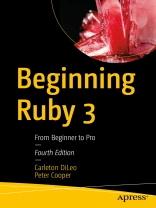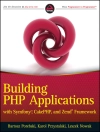Learn the principles behind object-oriented programming in Ruby and within a few chapters create a fully functional Ruby 3-based application. You’ll gain a basic understanding of many ancillary technologies such as databases, XML, web frameworks, and networking – some of which will be needed for your first Ruby application. Based on the bestselling first and second editions, Beginning Ruby 3, 4th Edition is a leading guide to learn Ruby from the ground up.
The new edition of this book provides the same excellent introduction to Ruby as the previous editions plus updates for the newest version of Ruby, including performance through an improved allocator, decreased heap fragmentation and more. Also, added: details on the just-in-time compiler, fewer limits on GIL (Global Interpreter Lock), and a static type checker.
You’ll see why the light and agile Ruby programming language remains a popular open source scripting option for developers building today’s web applications. This book can also be used as a textbook or companion to a textbook on beginning Ruby programming. After reading and using this book, you’ll have a firm handle to program in the Ruby language.
What You Will Learn
- Use the Ruby libraries, gems, and documentation Work with files and databases
- Write and deploy Ruby applications
- Harness the various Ruby web frameworks and use them effectively
- Do network programming with Ruby
Discover the fundamentals of Ruby and its object-oriented building blocks
Who This Book Is For
Beginning programmers, programmers new to Ruby, and web developers interested in learning the foundations of the Ruby programming language.Daftar Isi
Part 1 – Foundations and Scaffolding.- 1. Let’s Get It Started: Installing Ruby.- 2. Programming = Joy: A Whistle-Stop Tour of Ruby and Object Orientation.- 3. Ruby’s Building Blocks: Data, Expressions, and Flow Control.- 4. Developing Your First Ruby Application.- 5. The Ruby Ecosystem.- Part 2 – The Core of Ruby.- 6. Classes, Objects, and Modules.- 7. Projects and Libraries.- 8. Documentation, Error Handling, Debugging, and Testing.- 9. Files and Databases.- 10. Deploying Ruby Applications and Libraries.- 11. Advanced Ruby Features.- 12. Tying It Together: Developing a Larger Ruby Application.- Part 3 – Ruby Online.- 13. Web Application Frameworks: Rails, Sinatra, and Ramaze.- 14. Ruby and the Internet.- 15. Networking, Sockets, and Daemons.- 16. Useful Ruby Libraries.- Appendix A. Ruby Primer and Review for Developers.- Appendix B. Useful Resources.
Tentang Penulis
Carleton Di Leo is a founder, author, and developer who brings nearly two decades of experience working with technology. His expertise includes building high-traffic websites, big data systems, and video games. This wide base of knowledge provides Carleton with a unique perspective when working with Ruby.
Peter Cooper is an experienced Ruby developer, trainer, and publisher who runs Ruby Inside, the most popular blog in the Ruby and Rails worlds, with 18, 000 subscribers. He also curates Ruby Flow, a popular Ruby community link blog. Over the past few years he has developed, launched, and sold two startups (Feed Digest and Code Snippets), both powered by Ruby and Rails.












